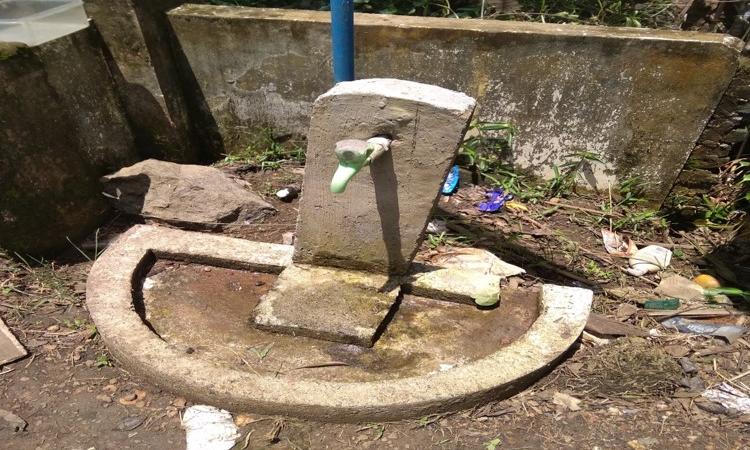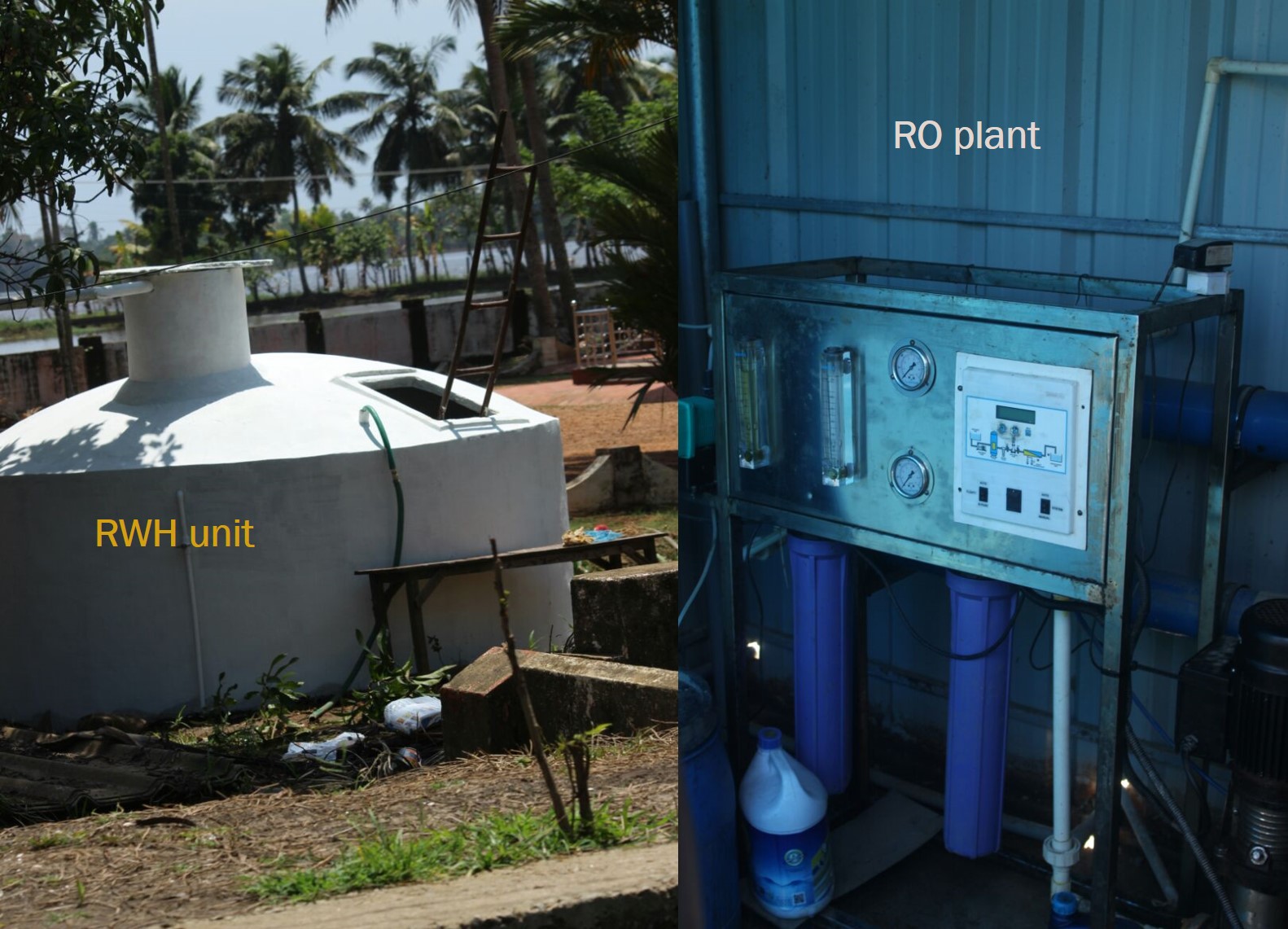
Surrounded by vast expanses of water, the Kuttanad region in Alleppey district, Kerala faces severe drinking water scarcity due to infrastructure failure and civic body inaction. This picture-perfect expanse that lies at the heart of the backwaters experiences “frequent floods, waterlogging, contamination from the houseboat and domestic effluents, degradation of natural reserves, poor sanitation and land management systems in the catchment and supply-demand mismatch” (Shiney and Geeja, 2013).
Water to cater to the needs of a population of 2.4 lakh population is sourced from the Neerettupuram plant in Thiruvalla that has a production of 14 million litres per day against a demand of 24 million litres. Nearly, half of the water gets lost through the supply system creating a huge shortfall in drinking water.
Groundwater is the only viable source for drinking water as open dug wells are not viable due to peculiar terrain and soil types. Unlike other town and cities in Kuttanad, water is directly pumped to consumers, as gravity feeding is not feasible (Saritha V Balan, 2018).
Water supply is inadequate and intermittent because of limited water availability. Most of the pipelines are set through paddy fields and get damaged quite often. Shallow pipelines, accumulation of silt, improper placing, rusting and damages lead to water leakages. Even viable alternatives like tubewells are not feasible in this location due to the peculiar geography and poor groundwater quality.
Traditional water harvesting systems on the decline
Few decades ago, plentiful drinking water of good quality was available in Kuttanad. In addition, there were man-made ponds locally called vallom, which used to store rainwater. This was connected to local canal or thodu and in the event of saline water intrusion from sea, the inflow to vallom were disconnected to prevent mixing up of sea water with fresh water.
During the mid-70’s, bunds were constructed as part of the Kuttanad development scheme to control sea water intrusion. When pipelines were laid in Kuttanad to augment drinking water supply, the vallom were disregarded. Degradation of surface water bodies contributed to the region’s water woes. Though a number of interventions were planned by the government and local bodies as a part of the Kuttanad package, the situation did not take a turn for the better.
The case of Kainakary village
Nearly 30,000 people live in about 5700 houses in 15 wards in Kainakary village. It is marked by poor road connectivity and elevated water levels. Most households use personal boats for transport. Houseboat tourism, domestic wastes and agriculture residues have deteriorated the water bodies, affecting the aquatic environment as well as public health.
Lack of sufficient quality water, poor pipe connectivity and frequent breakdown of existing pipelines are common. The situation gets aggravated due to the disappearance of traditional water management systems, poor sanitation coverage, lack of community participation and gender concerns.
Exclusive water supply projects were implemented in this region but failed to meet the needs of the area. Groundwater is the major source of drinking water and is supplied through pipelines provided with community taps, with very few individual houses having piped water supply. Wards in Kainakary such as Bhajanamadom and Chennamkary do not have access to piped water supply with some wards being faraway with the local thodu posing as an obstruction to laying of pipelines.
Alternative water supply
Panchayats supply water brought in boats and tankers to specific locations twice or thrice a week. Residents collect water from these collection points. In recent times, few reverse osmosis (RO) plants have been installed in one or two wards in Kainakary from where water can be collected through the payment of Rs.10 for a 20 litre can. Though water is purified in the plant, concerns remain on water discarded from the RO plant, on collection of water charges, operation and maintenance of plants etc.
Residents spend an average of Rs. 600 to Rs. 800 a month on procuring this. As demand for drinking water is huge, people especially from low income groups are paying a disproportionate share of their income to these private water suppliers.
Water harvesting is not common in Kainakary except in a few wards like Chennamkary, where there are nearly 90 such units. These are either individually owned or provided by the panchayat to socio-economically marginalized population. These structures sized between 5000 to 20,000 litres suffice for about 3-4 months post monsoon.
Poor residents often find it hard to maintain the system on a collective basis. They are unable to afford such costly units in their premises, space being a constraint. Additionally, post floods, the soils are fragile and cannot support huge rainwater harvesting units. The rainwater harvesting units built in schools are also in a neglected state due to poor community involvement.
Exploring feasible alternatives
No single solution can solve the drinking water concerns in Kainakary and a multi-fold approach is required. While certain solutions can be executed by the community, there are others that require support from the local bodies and the government. In the absence of inadequate infrastructure and resources needed to provide adequate drinking water, rainwater harvesting can serve as a practical solution that can be carried out at community level with support from the local government. While the construction of rainwater overhead tanks is unaffordable for the weaker sections of the community, replacing it with low capacity Sintex tanks can be the next best solution.

Some alternatives promoted by the local governing body, like the replacement of the old and rusted pipelines, finding new sources of fresh water, and the revival of vallom to conserve freshwater as a community initiative are helping augment the water supply.
Decentralisation of water supply, like the Netherland model that collects rain and stormwater and processes it to potable limits and supplies it to citizens, can also be another solution. Restoration of all surface water bodies and protection of sacred groves can help increase water availability.
Experts suggest roof water harvesting of all buildings in Alleppey town, its pooling at a common point and supplying this harvested water within the city through existing pipelines. Installation of RO plants is a costly option, and instead the available surface water can be cleaned and disinfected through low-cost technologies. The implementation of these macro-level options can augment the drinking water scarcity, but their implementation is questionable.
For the improvement of efficiency in water supply, Kuttanad is in need of reforms at the institutional and governance front through the strengthening of institutions, structural improvements as well as through private sector participation. However, finances for the improvement in the drinking water sector are a concern. Centralized solutions are impractical at this point of time because of the cost, time and efforts involved.
Decentralized simple micro-level supply systems in conjunction with low-cost water purification technology are the most feasible solution for improving drinking water in this region. The possibility for digging wells with concrete rings around as also purifying systems that can cater to 3 to 4 houses managed by the small group could be explored. These sustainable drinking water solutions can be applicable in Kuttanad as well as in areas where similar social and environment conditions exist.
About the author: Dr. Jayasree Vaidyanathan is a hydro-meteorologist working on water resources assessment and management. She is associated with School of Natural Sciences and Engineering at National Institute of Advanced Studies, Bengaluru. Her interests are in seeking solutions to drinking water problems across various geographies across India. She is presently working on value addition of aquatic weeds for women empowerment and environment sustainability.
Disclaimer: The views and opinions expressed in this article are those of the author and do not necessarily reflect the policy or position of India Water Portal.